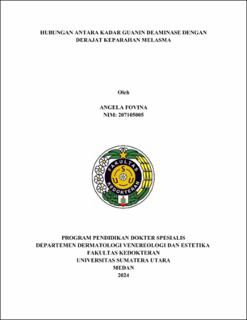Hubungan antara Kadar Guanin Deaminase dengan Derajat Keparahan Melasma
Relationship Between Guanine Deaminase Levels and Severity of Melasma

Date
2024Author
Fovina, Angela
Advisor(s)
Jusuf, Nelva Karmila
Dalimunthe, Dina Arwina
Metadata
Show full item recordAbstract
Background: Melasma is an acquired hyperpigmentation disorder on ultraviolet (UV)-exposed areas of skin, especially on the face. UV will cause keratinocytes to express paracrine factors such as guanine deaminase (GDA). Guanine deaminase will increase uric acid, stem cell factor (SCF), and endothelin-1 (ET-1), followed by increasing tyrosinase and microphthalmia-associated transcription factor (MITF), which are important transactivators in melanogenesis. Objective: Determine the correlation between GDA levels and the severity of melasma. Subjects and Methods: This study was an observational study with a crosssectional design on 40 melasma patients based on inclusion and exclusion criteria. Each patient underwent an anamnesis related to age, family history, and dermatological examination regarding the clinical pattern and type of melasma. The severity of melasma determined by Melasma Area and Severity Index (MASI) score. Followed by taking blood samples to assess GDA levels by ELISA test. The relationship between GDA levels and the severity of melasma was analyzed using the Gamma correlation test and significant if p-value <0.05. Results: Most melasma patients were found in the age 36–45 years (42.5%), had a family history of melasma (77.5%), with a centrofacial pattern (90%), and epidermal type (72.5%). Most melasma patients have moderate severity (50%). The mean GDA level in melasma was 27.64+-.66 mU/mL. The results of this study showed a positive correlation (p<0.05) with strong strength between GDA levels and the severity of melasma (r=0.649). Conclusion: There is a strong correlation between GDA levels and the severity of melasma.
Collections
- Master Theses [212]
